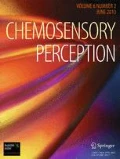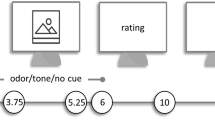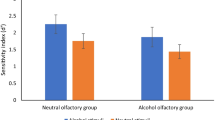Abstract
Introduction
Adverse effects of malodorous chemicals in humans are usually described as negative emotional reactions and impaired cognitive performance. Sensory acuity and automatic associations to odor words could influence cognitive processing of chemosensory stimulation and such adverse effects. We hypothesized that adverse effects are amplified in individuals with lower olfactory acuity due to a more automatic and emotional odor evaluation process. In contrast, adverse effects should be attenuated if odor words such as smell automatically activate positive mental associations.
Methods
After the assessment of olfactory acuity and automatically activated associations in standardized tests, 37 women were exposed to ascending concentration steps of ammonia (0–10 ppm) in an exposure laboratory for 75 min. Participants rated hedonic valence, intensity, and pungency of ammonia and performed working memory and response inhibition tasks.
Results
Olfactory acuity modulated ratings of hedonic valence and working memory performance: Participants with lower olfactory acuity reported stronger odor unpleasantness and showed impaired performance compared to participants with higher olfactory acuity during the exposure to 10 ppm ammonia. In the lower olfactory acuity group, participants with strong automatic associations between odor words and positive valence rated ammonia at high concentrations to be less pungent than participants with weaker automatic associations.
Conclusions
We conclude that sensory acuity and automatically activated associations modulate chemosensory-mediated adverse effects of ammonia. Beyond established self-report measures, these individual characteristics could help explain differences in environmental odor annoyance.




Similar content being viewed by others
References
Anderson AK, Christoff K, Stappen I et al (2003) Dissociated neural representations of intensity and valence in human olfaction. Nat Neurosci 6:196–202. doi:10.1038/nn1001
Andersson L, Claeson AS, Ledin L, Wisting F, Nordin S (2013) The influence of health-risk perception and distress on reactions to low-level chemical exposure. Front Psychol 4:816. doi:10.3389/fpsyg.2013.00816
Atanasova B, Graux J, El Hage W, Hommet C, Camus V, Belzung C (2008) Olfaction: a potential cognitive marker of psychiatric disorders. Neurosci Biobehav Rev 32:1315–1325. doi:10.1016/j.neubiorev.2008.05.003
Blanes-Vidal V, Nadimi ES, Ellermann T, Andersen HV, Lofstrom P (2012) Perceived annoyance from environmental odors and association with atmospheric ammonia levels in non-urban residential communities: a cross-sectional study. Environ Health 11:27. doi:10.1186/1476-069X-11-27
Bulsing PJ, Smeets MA, van den Hout MA (2007) Positive implicit attitudes toward odor words. Chem Senses 32:525–534. doi:10.1093/chemse/bjm021
Bulsing PJ, Smeets MA, van den Hout MA (2009) The implicit association between odors and illness. Chem Senses 34:111–119. doi:10.1093/chemse/bjn062
Danuser B, Moser D, Vitale-Sethre T, Hirsig R, Krueger H (2003) Performance in a complex task and breathing under odor exposure. Hum Factors 45:549–562. doi:10.1518/hfes.45.4.549.27093
Doty RL, Smith R, McKeown DA, Raj J (1994) Tests of human olfactory function: principal components analysis suggests that most measure a common source of variance. Percept Psychophys 56:701–707. doi:10.3758/BF03208363
Duncko R, Johnson L, Merikangas K, Grillon C (2009) Working memory performance after acute exposure to the cold pressor stress in healthy volunteers. Neurobiol Learn Mem 91:377–381. doi:10.1016/j.nlm.2009.01.006
Green BG, Dalton P, Cowart B, Shaffer G, Rankin K, Higgins J (1996) Evaluating the ‘Labeled Magnitude Scale’ for measuring sensations of taste and smell. Chem Senses 21:323–334. doi:10.1093/chemse/21.3.323
Greenwald AG, McGhee DE, Schwartz JL (1998) Measuring individual differences in implicit cognition: the implicit association test. J Pers Soc Psychol 74:1464–1480. doi:10.1037/0022-3514.74.6.1464
Greenwald AG, Nosek BA, Banaji MR (2003) Understanding and using the implicit association test: I. An improved scoring algorithm. J Pers Soc Psychol 85:197–216. doi:10.1037/0022-3514.85.2.197
Habel U, Koch K, Pauly K et al (2007) The influence of olfactory-induced negative emotion on verbal working memory: individual differences in neurobehavioral findings. Brain Res 1152:158–170. doi:10.1016/j.brainres.2007.03.048
Habel U, Pauly K, Koch K et al (2010) Emotion-cognition interactions in schizophrenia. World J Biol Psychiatry 11:934–944. doi:10.3109/15622975.2010.501820
Hedner M, Larsson M, Arnold N, Zucco GM, Hummel T (2010) Cognitive factors in odor detection, odor discrimination, and odor identification tasks. J Clin Exp Neuropsychol 32:1062–1067. doi:10.1080/13803391003683070
Hey K, Juran SA, Schäper M et al (2009) Neurobehavioral effects during exposures to propionic acid—an indicator of chemosensory distraction? Neurotoxicology 30:1223–1232. doi:10.1016/j.neuro.2009.08.009
Hummel T, Livermore A (2002) Intranasal chemosensory function of the trigeminal nerve and aspects of its relation to olfaction. Int Arch Occup Environ Health 75:305–313. doi:10.1007/s00420-002-0315-7
Hummel T, Sekinger B, Wolf SR, Pauli E, Kobal G (1997) ‘Sniffin’ sticks’: olfactory performance assessed by the combined testing of odor identification, odor discrimination and olfactory threshold. Chem Senses 22:39–52. doi:10.1093/chemse/22.1.39
Hummel T, Kobal G, Gudziol H, Mackay-Sim A (2007) Normative data for the “Sniffin’ Sticks” including tests of odor identification, odor discrimination, and olfactory thresholds: an upgrade based on a group of more than 3,000 subjects. Eur Arch Otorhinolaryngol 264:237–243. doi:10.1007/s00405-006-0173-0
Hüttenbrink KB, Hummel T, Berg D, Gasser T, Hähner A (2013) Olfactory dysfunction: common in later life and early warning of neurodegenerative disease. Dtsch Arztebl Int 110:1–7. doi:10.3238/arztebl.2013.0001
Juran SA, van Thriel C, Kleinbeck S, Schäper M, Falkenstein M, Iregren A, Johanson G (2012) Neurobehavioral performance in human volunteers during inhalation exposure to the unpleasant local irritant cyclohexylamine. Neurotoxicology 33:1180–1187. doi:10.1016/j.neuro.2012.06.014
Juran SA, van Thriel C, Kleinbeck S, Schäper M, Falkenstein M, Iregren A, Johanson G (2013) Electrophysiological correlates of impaired response inhibition during inhalation of propionic acid. J Psychophysiol 27:131–141. doi:10.1027/0269-8803/a000098
Juran SA, Johanson G, Ernstgard L, Iregren A, van Thriel C (2014) Neurobehavioral performance in volunteers after inhalation of white spirits with high and low aromatic content. Arch Toxicol 88:1127–1140. doi:10.1007/s00204-014-1236-4
Kärnekull SC, Jonsson FU, Larsson M, Olofsson JK (2011) Affected by smells? Environmental chemical responsivity predicts odor perception. Chem Senses 36:641–648. doi:10.1093/chemse/bjr028
Knaapila A, Tuorila H, Kyvik KO et al (2008) Self-ratings of olfactory function reflect odor annoyance rather than olfactory acuity. Laryngoscope 118:2212–2217. doi:10.1097/MLG.0b013e3181826e43
Koch K, Pauly K, Kellermann T et al (2007) Gender differences in the cognitive control of emotion: an fMRI study. Neuropsychologia 45:2744–2754. doi:10.1016/j.neuropsychologia.2007.04.012
Liden E, Nordin S, Hogman L, Ulander A, Deniz F, Gunnarsson AG (1998) Assessment of odor annoyance and its relationship to stimulus concentration and odor intensity. Chem Senses 23:113–117. doi:10.1093/chemse/23.1.113
Lim J, Wood A, Green BG (2009) Derivation and evaluation of a labeled hedonic scale. Chem Senses 34:739–751. doi:10.1093/chemse/bjp054
Lundström JN, Seven S, Olsson MJ, Schaal B, Hummel T (2006) Olfactory event-related potentials reflect individual differences in odor valence perception. Chem Senses 31:705–711. doi:10.1093/chemse/bjl012
Mainland J, Sobel N (2006) The sniff is part of the olfactory percept. Chem Senses 31:181–196. doi:10.1093/chemse/bjj012
Martin GN, Chaudry A (2014) Working memory performance and exposure to pleasant and unpleasant ambient odor: is spatial span special? Int J Neurosci 124:806–11. doi:10.3109/00207454.2014.890619
Maxwell SE, Delaney HD (1993) Bivariate median splits and spurious statistical significance. Psychol Bull 113:181–190. doi:10.1037/0033-2909.113.1.181
Millot JL, Brand G, Morand N (2002) Effects of ambient odors on reaction time in humans. Neurosci Lett 322:79–82. doi:10.1016/S0304-3940(02)00092-7
Nordin S, Claeson A-S, Andersson M, Sommar L, Andrée J, Lundqvist K, Andersson L (2013) Impact of health-risk perception on odor perception and cognitive performance. Chemosens Percept 6:190–197. doi:10.1007/s12078-013-9153-0
Österberg K, Ørbæk P, Karlson B, Akesson B, Bergendorf U (2003) Annoyance and performance during the experimental chemical challenge of subjects with multiple chemical sensitivity. Scand J Work Environ Health 29:40–50. doi:10.5271/sjweh.703
Österberg K, Persson R, Karlson B, Ørbæk P (2004) Annoyance and performance of three environmentally intolerant groups during experimental challenge with chemical odors. Scand J Work Environ Health 30:486–496. doi:10.5271/sjweh.838
Reske M, Kellermann T, Shah NJ, Schneider F, Habel U (2010) Impact of valence and age on olfactory induced brain activation in healthy women. Behav Neurosci 124:414–422. doi:10.1037/a0019289
Rohlman DS, Lucchini R, Anger WK, Bellinger DC, van Thriel C (2008) Neurobehavioral testing in human risk assessment. Neurotoxicology 29:556–567. doi:10.1016/j.neuro.2008.04.003
Schneider F, Koch K, Reske M et al (2006) Interaction of negative olfactory stimulation and working memory in schizophrenia patients: development and evaluation of a behavioral neuroimaging task. Psychiatry Res 144:123–130. doi:10.1016/j.psychres.2004.12.013
Seubert J, Freiherr J, Frasnelli J, Hummel T, Lundström JN (2013) Orbitofrontal cortex and olfactory bulb volume predict distinct aspects of olfactory performance in healthy subjects. Cereb Cortex 23:2448–2456. doi:10.1093/cercor/bhs230
Smeets MAM, Dijksterhuis GB (2014) Smelly primes—when olfactory primes do or do not work. Front Psychol 5:96. doi:10.3389/fpsyg.2014.00096
Smeets MA, Bulsing PJ, van Rooden S et al (2007) Odor and irritation thresholds for ammonia: a comparison between static and dynamic olfactometry. Chem Senses 32:11–20. doi:10.1093/chemse/bjl031
Sucker K, Both R, Bischoff M, Guski R, Kramer U, Winneke G (2008) Odor frequency and odor annoyance. Part II: dose-response associations and their modification by hedonic tone. Int Arch Occup Environ Health 81:683–694. doi:10.1007/s00420-007-0262-4
Thuerauf N, Reulbach U, Lunkenheimer J et al (2009) Emotional reactivity to odors: olfactory sensitivity and the span of emotional evaluation separate the genders. Neurosci Lett 456:74–79. doi:10.1016/j.neulet.2009.03.096
Tsuchida A, Fellows LK (2008) Lesion evidence that two distinct regions within prefrontal cortex are critical for n-back performance in humans. J Cogn Neurosci 21:2263–2275. doi:10.1162/jocn.2008.21172
van Thriel C, Kiesswetter E, Blaszkewicz M, Golka K, Seeber A (2003) Neurobehavioral effects during experimental exposure to 1-octanol and isopropanol. Scand J Work Environ Health 29:143–151. doi:10.5271/sjweh.716
van Thriel C, Kiesswetter E, Schäper M et al (2007) From neurotoxic to chemosensory effects: new insights on acute solvent neurotoxicity exemplified by acute effects of 2-ethylhexanol. Neurotoxicology 28:347–355. doi:10.1016/j.neuro.2006.03.008
Van Thriel C, Kiesswetter E, Schäper M, Juran SA, Blaszkewicz M, Kleinbeck S (2008) Odor annoyance of environmental chemicals: sensory and cognitive influences. J Toxicol Environ Health A 71:776–785. doi:10.1080/15287390801985596
Wehling E, Lundervold AJ, Nordin S (2014) Does it matter how we pose the question “how is your sense of smell?”. Chemosens Percept 7:103–107. doi:10.1007/s12078-014-9171-6
Witthöft M, Rist F, Bailer J (2009) Abnormalities in cognitive-emotional information processing in idiopathic environmental intolerance and somatoform disorders. J Behav Ther Exp Psychiatry 40:70–84. doi:10.1016/j.jbtep.2008.04.002
Acknowledgments
This research was supported by the DGUV—German Social Accident Insurance, Berlin, Germany (FF-FP0326). The study sponsor had no influence in the collection, analysis, and interpretation of data; in the writing of the report; or in the decision to submit the paper for publication.
The authors would like to thank Nicola Schmidt-Peucker, Eva Strzelec, Michael Porta, and Beate Aust for technical assistance and Leah Boccaccio for proofreading.
Author information
Authors and Affiliations
Corresponding author
Ethics declarations
Conflict of Interest
Marlene Pacharra, Michael Schäper, Stefan Kleinbeck, Meinolf Blaszkewicz, and Christoph van Thriel declare that they have no conflict of interest.
Ethical Approval
All procedures performed were in accordance with the ethical standards of the institutional and national research committee and with the 1964 Helsinki declaration and its later amendments.
Informed Consent
Informed consent was obtained from all individual participants included in the study.
Rights and permissions
About this article
Cite this article
Pacharra, M., Schäper, M., Kleinbeck, S. et al. Olfactory Acuity and Automatic Associations to Odor Words Modulate Adverse Effects of Ammonia. Chem. Percept. 9, 27–36 (2016). https://doi.org/10.1007/s12078-016-9202-6
Received:
Accepted:
Published:
Issue Date:
DOI: https://doi.org/10.1007/s12078-016-9202-6




